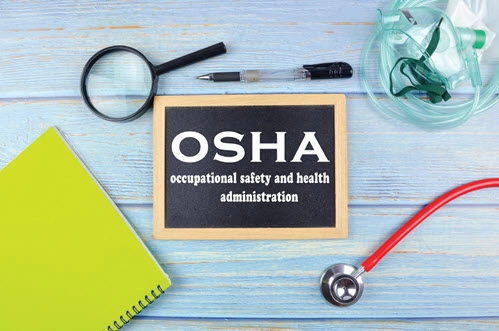Health Information Compliance Alert
See the Latest OSHA Guidelines on COVID-19
Tip: Ensure patients’ privacy and rights are protected, too.
A recent release offers new advisory guidance from the Occupational Safety and Health Administration (OSHA) with a glimpse at mandatory COVID-19-related requirements to come.

Lowdown: On Jan. 29, OSHA issued a new guidance document, “Protecting Workers: Guidance on Mitigating and Preventing the Spread of COVID-19 in the Workplace.” The guidance aims to “inform employers and workers in most workplace settings outside of healthcare to help them identify risks of being exposed to and/ or contracting COVID-19 at work and to help them determine appropriate control measures to implement,” OSHA says on its website.
OSHA issued the guidance in response to the “Executive Order on Protecting Worker Health and Safety” signed by President Biden on Jan. 21, the day after his inauguration.
Caveat: While providers may be careful to follow Centers for Disease Control and Prevention (CDC) guidance in patient care, they may not be quite as stringent in their back offices and other non-patient-care areas.
OSHA notes that its recommendations in the guidance are “advisory.” However, don’t be surprised to see them turn mandatory soon. The executive order requires OSHA to “consider whether any emergency temporary standards on COVID-19, including with respect to masks in the workplace, are necessary, and if such standards are determined to be necessary, issue them by March 15, 2021.”
“If OSHA moves forward with issuing an emergency temporary standard (ETS), we expect that many of the recommendations in this guidance will become part of the ETS,” say attorneys Mark Duvall, Jayni Lanham, and Deepti Gage with law firm Beveridge & Diamond in online analysis.
OSHA, similar to HIPAA, is in the business of protecting people’s health, data, and rights. This new release touches on several COVID-19 matters and ideas to inform staff about the dangers of the virus while ensuring the workplace is safe.
Consider asking yourself these OSHA-inspired questions as you plan on how to train staff, manage COVID-19 cases among employees, and communicate the protocols — and the dangers — of the virus:
- Do you have a COVID-19 coordinator on staff?
- Have you assessed your organization’s risks on employees contracting the virus?
- What mitigation steps have you taken to ensure workers’ safety?
- Are your policies and procedures in line with federal health, privacy, and workplace standards?
- Do you have “reasonable accommodations” to protect older or disabled employees, who are at a higher risk of getting sick?
- Have you instituted a comprehensive training program that instructs employees on the most recent mandates related to masks, personal protective equipment (PPE), barriers, ventilation, cleaning, and disinfecting?
- Do you have screening and isolation policies in place for before, during, and after shifts?
- Are your protocols proactive, encouraging sick employees to stay home without fear of repercussions?
- Have you enabled an alert system that allows employees to know when a co-worker has come down with COVID-19 while ensuring the sick individual’s privacy and health data are protected?
- Is your IT enabled to track and report staff cases of COVID-19?
- Do you have a plan in place that promotes COVID-19 vaccination while not infringing on workers’ rights or choices to not get inoculated, too?
Resource: Review the OSHA guidance is at www.osha.gov/coronavirus/safework.
Health Information Compliance Alert
- Case Study:
Don’t Be Fooled by Vendors’ ‘HIPAA-Compliant’ Labels
Tip: Investigate BAs’ HIPAA track records. Many vendors target the healthcare market with promises that [...] - Business Associates:
Evaluate Your BAs’ HIPAA IQ Before a Breach Happens
Hint: Understand what OCR means by ‘satisfactory assurances.’ For covered entities (CEs), one of the [...] - Practice Management:
See the Latest OSHA Guidelines on COVID-19
Tip: Ensure patients’ privacy and rights are protected, too. A recent release offers new advisory [...] - Labor Law:
Know the Facts on Mandatory Vaccines Under ADA, Title VII
Critical: Would an unvaccinated person pose a ‘direct threat’ under the law? If you’re struggling [...] - COVID-19 Toolkit:
Check Out Online Tools to Bolster Your Vaccination Rollout
Tip: Check specialty orgs for differentiated professional advice. Whether you’re creating a COVID-19 vaccination training [...] - Reader Question:
Prepare Now for Cures Act Compliance Requirements
Question: We haven’t seen any new updates on the 21st Century Cures Act compliance deadlines [...] - Enforcement News:
OIG Sets Record Straight on Telehealth Fraud Enforcement
If you’ve noticed a spike in telehealth fraud talk from the feds, you’re not alone. [...] - Enforcement News:
Feds Declare PHE for Texas After Winter Mayhem
As with past natural disasters and the COVID-19 pandemic, Centers for Medicare & Medicaid Services [...] - Enforcement News:
Industry Group Advocates for State-Aligned Privacy Regs
With the aim of encouraging more discourse on a national privacy law, Consumer Reports published [...] - Enforcement News:
Submit 2020 Medicare PI Data ASAP
If you haven’t submitted your Promoting Interoperability (PI) Program data for 2020 yet, the deadline [...]

